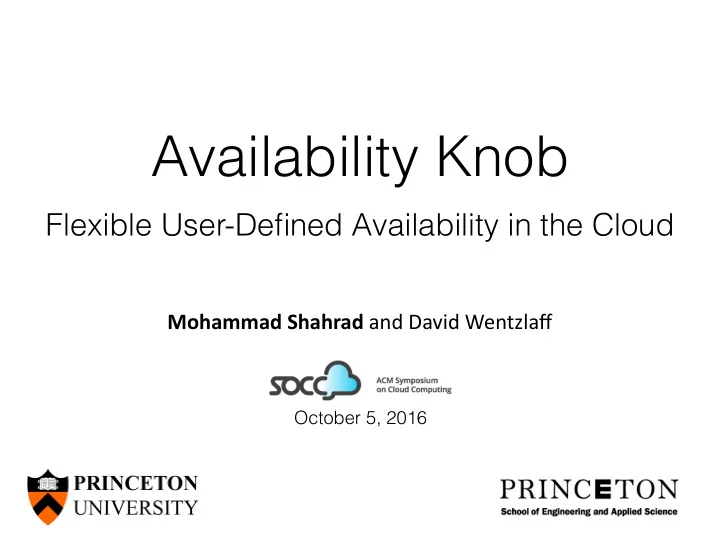

Availability Knob Flexible User-Defined Availability in the Cloud Mohammad Shahrad and David Wentzlaff October 5, 2016
IaaS Providers and Availability Guarantees One thing in common: Fixed 99.95% availability! 2
What’s wrong with fixed availability? Cloud infrastructures: Cloud customers: • Heterogeneous HW & • Various downtime demands • Different WTP* SW reliability * WTP= Willingness to Pay 3
The Availability Knob (AK) Let’s have clients ask for their desired availability and be charged correspondingly. 4
Cloud Cloud Scheduler What should change in Scheduler cloud to support AK? Service Level Agreements (SLAs) Cloud Cloud Cloud Cloud Cloud Scheduler Scheduler Scheduler Scheduler Scheduler Cloud management • Gathering failure data and build failure stats • Avail-aware scheduling 5 Cloud Cloud Scheduler Scheduler
How do SLAs look with AK? 1. Desired Avail. / Period 2. Availability price scale (e.g. 99.8% / 7 days) e.g. (99.95%,1.00), (99.9%,0.95) 3. Variable service credit (penalty) 6
The AK Scheduler PM* Failure DB Service Record DB 1. Check for available resources 2. Find the cheapest resource considering possible penalties using: Expected PM time-to-next-failure VM size and expected DT** length in case of failure User’s experienced vs. requested DT * PM= Physical Machine ** DT= Downtime 7
AK-Specific Scheduler Features Extra Knowledge on user availability demand enables new scheduling features: Benign VM* Migration (BVM) Deliberate Downtimes (DDT) * VM= Virtual Machine 8
Benign VM Migration (BVM) • VMs can be over-served • Low failure rate • Assignment to HR resources (resource shortfall) Periodic migration of over-served VMs to cheaper resources * DTF= Downtime Fulfillment ** SLO= Service Level Objective 9
Deliberate Downtimes (DDT) • Providers can deliberately fail VMs near the end of period. Motivations: • • Bidding redeemed resources Building market incentives • • etc. Lowering energy consumption • Delivered Avail. Safety Margin Requested Avail. 10
Economics of AK How to set prices to ensure mutual benefit? How does AK make money? 11
Incentive Compatibility Providers can: Clients may: - run buggy VMs - neglect meeting SLOs* - cause deliberate DTs**. Pricing for incentive compatibility Using game theory to ensure: - Providers maximize profit margin by not violating SLOs - Clients pay less by asking their true demands * SLO= Service Level Objective ** DT = Downtime 12
How does AK make money? 1. Adapting service to real demand: Higher market efficiency through supply chain flexibility 2. More efficient resource utilization: Lowering OpEx, Extra Bidding/Sprinting 3. Variable profit margins: Compensates risks & supply/demand disparity ~10% Cost Reduction ~20% Profit Increase 13
AK Deployment • No hardware change required • Low technology adoption cost • Existing fixed availability a subset of AK • Can be offered as an optional feature • Easy shift to the new model 14
How to evaluate AK? Infrequency of Failures Accelerated testing Simulations Data center scale 1. Stochastic simulations in MATLAB [1] 2. Prototype implementation with OpenStack [1] http://gdkomeg.en.made-in-china.com/productimage 15
AKSim: Stochastic Cloud Simulator Various Machine Types Scalability (cost/resilience trade-off) Resolution/Accuracy trade-off Diverse Applications Multiple VMs 16
OpenStack AK Prototype 17
Availability-aware Scheduler 1000 machines, 12000 users, Normal demand dist., 6 month BVM every 1hr for top 10% of over-served clients 18
Benign VM Migration (BVM) ~7% Cost Reduction Increased Miss Rate 0.19% 0.34% Benefits of BVM depend on machine type blend 1000 machines, 12000 users, Uniform demand dist. [3 nines,5 nines], 30 days and data-center utilization . BVM every 1hr for top 10% of over-served clients 19
Deliberate Downtimes (DDT) DDT Benefits of DDT depend on demand distribution . 1000 machines, 12000 users, Normal demand dist. [3 nines,5 nines], 6 month BVM every 1hr for top 10% of over-served clients 20
Improved Service Satisfaction AK Satisfaction Fixed-avail Satisfaction Downtime Price * WTP= Willingness to Pay 21
Things to Remember • Supply chain flexibility -> market efficiency • Knowing user demand can enable new techniques • Game theory to ensure mutual economic incentive • Leveraging reliability/cost trade-offs 22
The Availability Knob Mohammad Shahrad mshahrad@princeton.edu 23
Back-up Slides
What if client’s demand changed? Client must have the incentive to change his plan. Upper bound of SC given arbitrary P Price Plan update condition: No change; Fixed A 1 PA 1 deliberate failures by PA 1 − SCA 1 ( α A 1 +(1 −α ) A 2 ) user to earn cash back α PA 1 +(1 −α ) PA 2 Change to A 2 25
Nash Equilibrium Nash equilibrium: 26
Catastrophic Failure & AK • When the whole cloud service is down. 100 90 80 70 Missed SLOs (%) 60 50 40 30 20 AK (Uniform Dist) 10 Fixed Availability 0 0 1 2 3 4 5 6 7 8 Catastrophic Event Length (Hour) 27
Why OpenStack • VM migration (unlike Eucalyptus) • Diverse hypervisor support (KVM) • AWS Compatibility • Big community (good support) • Real world adoption in public/private/hybrid clouds 28
Some More Results 29
Service Credit Reshaping 30
Availability Monitoring Tools • There are some performance monitoring tools AK can use to gather avail data: • Nagios (used in AWS) • Zabbix • Ganglia 31
Recommend
More recommend